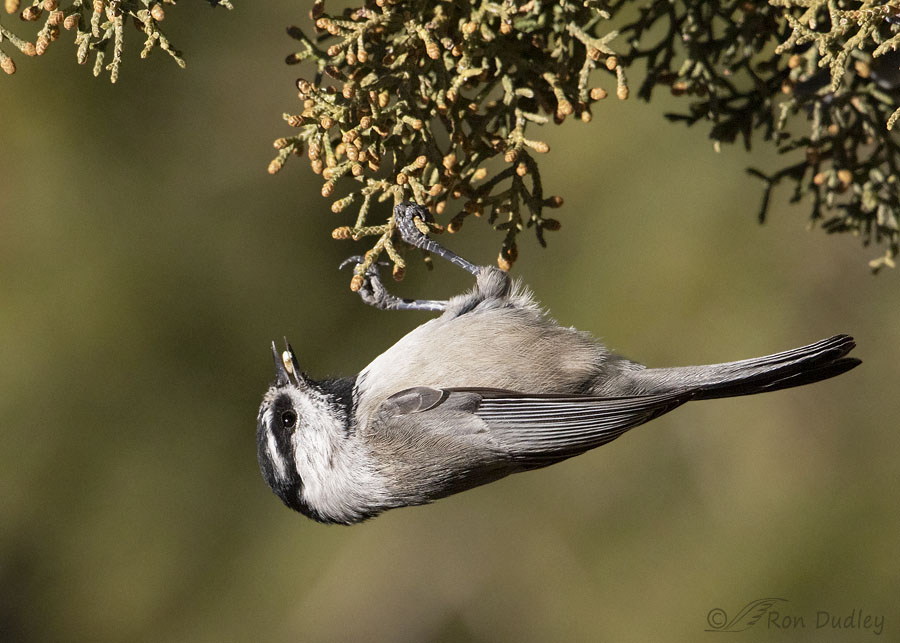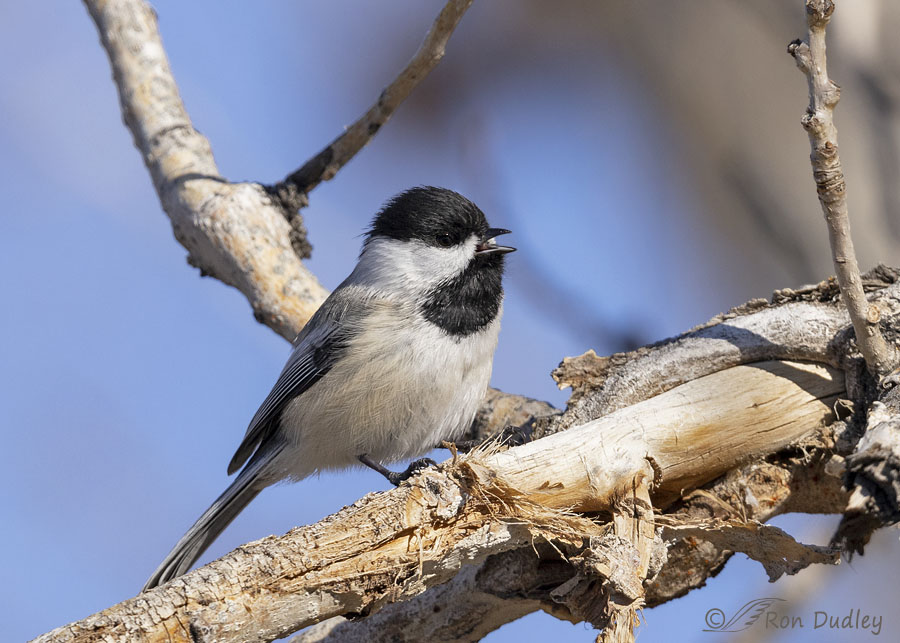Including the primary difference between Mountain Chickadees and Black-capped Chickadees.

1/6400, f/6.3, ISO 800, Canon 7D Mark II, Canon EF500mm f/4L IS II USM + 1.4 tc, not baited, set up or called in
I found this Mountain Chickadee in mid-November four years ago in the mountains of the west desert. ‘He’ was hanging upside down on a juniper and appeared to be feeding on some of its scale leaves, which surprised me. I thought they fed on invertebrates and conifer seeds exclusively.
I was pleased to catch him in a broadside pose with a clean background.
When I’ve posted photos of Mountain Chickadees in the past, some of my viewers have been confused. Mountain Chickadees are exclusively a western bird so some folks assumed they were photos of the far more widespread Black-capped Chickadee that I had just called Mountain Chickadees because I photographed them in the mountains.
They’re closely related but Mountain Chickadees and Black-capped Chickadees are two distinct species.

This is a Black-capped Chickadee. Notice that in this species the black cap extends down uninterrupted to below the eye. But the Mountain Chickadee has a white “eyebrow” (supercilium) that interrupts the black cap between the eye and the top of the head. There are a few other more minor differences too.
“Where the ranges of the 2 species overlap in the Rocky Mountains, they tend to segregate by habitat, but where both are sparse, most notably in the Rio Grande valley of New Mexico, they may hybridize extensively.”
Ron
PS – Fall has hit northern Utah with a vengeance. Right now (just after 6 AM) it’s in the high 40’s with a cold rain. It won’t be long before BLTs with garden tomatoes will be a thing of the past.


A topsy turvey charmer. And useful identification for those lucky enough to see them and their relatives. Thank you.
Home grown matoes are a total treat. Store bought? Bleah.
EC, your ‘mater-planting season is just around the corner. Hope you plant some.
Of course. Several varieties.
We have both here in Central Washington and I have seen them doing the hanging foraging trick in our spruce trees. Such fun birds. They are the sentries for the yard, too, warning about the hawks, and giving the all-clear when danger is past. It’s very interesting to watch the quail freeze for 20 mins when the hawk warning has been given, and then start moving again when the chickadees say it is ok.
Interesting about the chickadees and the quail, Caroline. An early warning system of sorts.
I have always loved some of these photos you captured of the chickadees hanging on the conifers. I get both types in my yard. Not as many of the mountain chickadees. The black-capped are here year round, the mountain come early spring and late fall, some times they stay for the winter. They really like my homemade peanut butter suet.
Thanks, April. I get Black-capped in my yard but not many of them. I never get Mountain.
The Black Cap Chickadees are a favorite at my feeder year round. I love to see them every day.
Trudy, you have lots of company in that regard.
Great photos of the Chickadees along with another FP lesson in identification.
Always amazed at the species of small birds, like the Chickadee, that are seemingly so comfortable in perching in any old orientation they need to be in to feed.
I am also amazed that you still have garden tomatoes! Here is So Cal we picked the last of ours a couple weeks ago. A BLT with a garden tomato is definitely one of my favorite meals.
Michael, one year I had garden tomatoes all the way to Thanksgiving. I had to cover the plants at night for a few weeks and they weren’t quite as good as they’d been when it was warmer, but they still beat the hell out of the poor excuse for tomatoes they sell at grocery stores.
Amazing!
I love both these photos and am glad that you’re reaching back
into your extensive files–lotta “gold” in there, I see !
Kris, after today our weather’s supposed to clear up. So hopefully I’ll soon have some new photos to post.
Sensational shots!
Charlotte Norton
Thanks.
Think we have Black-Capped BUT will have to look a little closer as ours seem larger than the black-capped shown.
Good rain last night with more to come today. Only fruit down low for tomatoes for us remaining – whitetailed deer figured out how to push down the chicken wire for the rabits and ate the top of my tomato plants as well as any red fruit – also took out the pepper plants……… They also took out a couple of the Amaranth plants… Will finally have to give in and put in good fencing – haven’t wanted to do that BUT!
They also took out a couple of the Amaranth plants… Will finally have to give in and put in good fencing – haven’t wanted to do that BUT!
Judy, Sibley lists the two species as the same size by weight – .39 oz.
Sounds like you have a fencing job ahead of you. So do I, my back fence is on its last legs.
Black caps – just sleeker then what you showed. Biggest surprise has been a little “creeper” hitting the feeder also!
Just HATE looking through a fence at a garden not to mention the work……
Your comment just made me realize what is most likely going on with some of my vegetables this year. Something has been eating my tomato plants, green beans, sweet peppers, and coleus but not the egg plants or my flowers. I thought maybe the raccoons or possibly a deer again but the deer did not eat some of the above mentioned in the past, mostly they ate my petunias in planters and coleus. I bet it is rabbits I am having trouble with this year. I live on a gully who’s creek comes down from the foothills. My friend on the other side of the gully has posted photos of wild rabbits in her back yard this year. We also have a coyote in the gully again this summer, who is probably after the rabbits that came down with the heavy snow last winter and spring.
Nice shots and an interesting post. I have never knowingly seen a Mountain Chickadee. Interesting because we show them to be common here. I have seen both their Bridled and Juniper Titmice relations, but never them. I used to hike often in our mountains, but now pretty much stick to our lower elevations. Maybe that is why I am not seeing them.
“Maybe that is why I am not seeing them.”
Probably. They’re found primarily in coniferous forests. Thanks, Everett.
I love chickadees – they are one of my many “favorite” birds. I have never seen a mountain chickadee but I will put them on my bucket list for my future Western adventure. These photos are great! I have made many a photo of black capped chickadees and their faces and beaks are so often covered with cobwebs and other debris that I rarely get photos that are even close to this lovely! Thanks again for sharing your work and knowledge.
Joanne, on the other hand, I’d love to get photos of chickadees with “cobwebs and other debris” on their faces. Gives’em character…